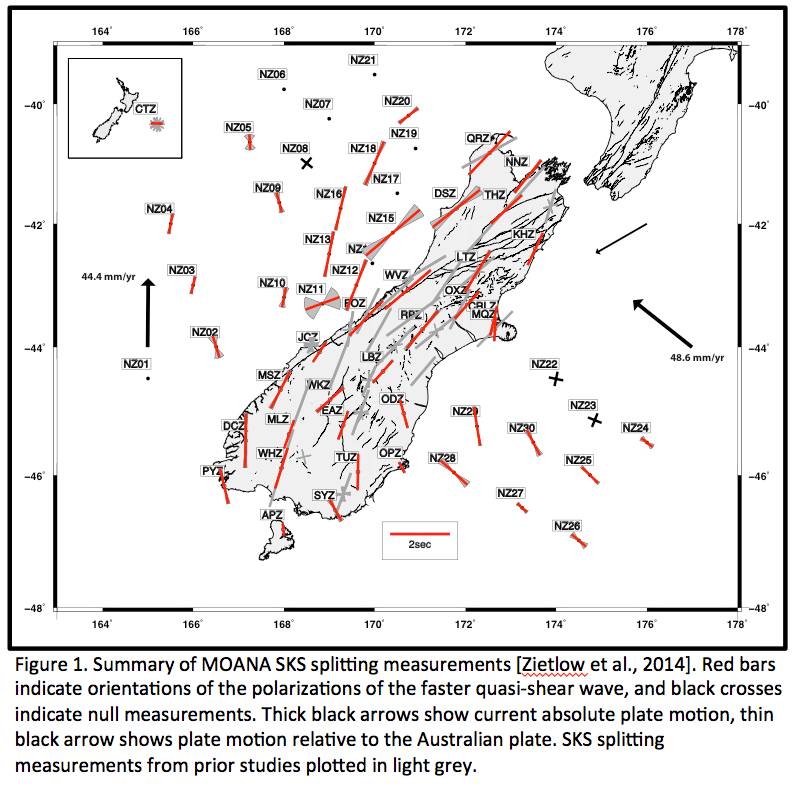Anne F. Sheehan

Ph.D. Massachusetts Inst. of Technology, 1991
Professor of Geophysics (Geophysics Program)
Associate Director, Solid Earth Sciences
E-mail: afs-at-cires.colorado.edu
Office: ESCI 440A
Phone: 303-492-4597
Web: Sheehan Research Group
Research Interests
Seismology, Geophysics, Earth Structure
Current Research: Earthquake and oceanography studies with ocean-bottom seismometers
In May 2014, CIRES graduate students Justin Ball and Jenny Nakai and I joined an international team with researchers from the United States, Japan, and New Zealand to deploy 34 ocean-bottom seismometers and seafloor pressure gauges offshore the east coast of the North Island of New Zealand. The project is part of a study of earthquake processes and slow slip.
Slow-slip events are earthquake-like tectonic movements that take days to weeks to happen rather than seconds. They are best detected using strain measurements such as GPS, and in the Hikurangi experiment we will experiment with detecting the vertical component of slow slip by using seafloor pressure readings. Understanding slow slip can help us understand earthquake processes, particularly at plate convergence zones where huge earthquakes are possible. The ‘megathrust’ earthquakes that happen at subduction zones can generate tsunamis and are a large threat to coastal communities. Some studies have suggested that slow slip may precede large earthquakes, but more research is needed to confirm that hypothesis.
In other research efforts related to ocean-bottom seismic recordings, I, along with graduate student Daniel Zietlow and CIRES Fellow Peter Molnar, have published results from a previous ocean-bottom seismic experiment held off the South Island of New Zealand. Zietlow used recordings from distant earthquakes to map out variations in seismic anisotropy in the mantle beneath New Zealand. The anisotropy is caused by alignment of minerals in the mantle and can be used to infer the history of a localization of deformation. This study provides information for better understanding plate boundary transform faults, in particular the Alpine Fault in New Zealand but also the San Andreas Fault in California, which has many similarities.
The ocean-bottom seismic recordings have proven useful for a number of other studies of earth structure (Ball et al., 2014), earthquakes (Wech et al., 2013; and Boes et al., 2013), and oceanography (Godin et al., 2013; and Godin et al., 2014), which have been conducted with CIRES and international collaborators.
Ball, JS, AF Sheehan, JC Stachnik, FC Lin, and JA Collins. 2014. A joint Monte Carlo analysis of seafloor compliance, Rayleigh wave dispersion and receiver functions at ocean bottom seismic stations offshore New Zealand. Geophys., Geochem., Geosyst. Submitted.
Godin, OA, NA Zabotin, AF Sheehan, and JA Collins. 2014. Interferometry of infragravity waves off New Zealand. J. Geophys. Res. Oceans. 119.
Zietlow, DW, AF Sheehan, PH Molnar, MK Savage, G Hirth, JA Collins, and BH Hager. 2014. Upper mantle seismic anisotropy at a strike slip boundary: South Island, New Zealand. J. Geophys. Res. Solid Earth. 119.

Past research:
Bighorn Arch Seismic Experiment
Publications
Click here for a complete list of published works »
PDF files of Sheehan publications can be found on the Sheehan Research Group site.
Also ...
Sheehan is a CIRES Professor.

